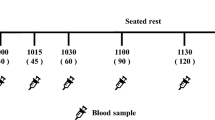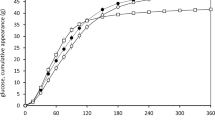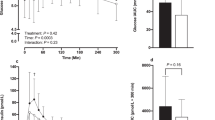Abstract
Background/Objectives:
‘Slowly digestible’ carbohydrates have been claimed to reduce appetite through their effects on postprandial glucose and insulin levels, but literature is inconsistent. The inconsistencies between studies might be explained by factors other than glycemic effects per se, for example, nutritional or physical properties. We tested this possibility by examining postprandial glucose, insulin and appetite responses to drinks differing only in rate and extent of digestibility of carbohydrates. This was accomplished by comparing different glucose polymers: maltodextrin (rapidly digestible) versus medium-chain pullulan (slowly but completely digestible) versus long-chain pullulan (indigestible).
Subjects/Methods:
In a randomized double-blind balanced crossover design, 35 subjects received drinks with 15 g test carbohydrate polymers. Key outcome measures were appetite scores, digestibility (in vitro test and breath hydrogen), and (in a subset) glucose and insulin levels.
Results:
Digestibility, glucose and insulin data confirmed the rapid, slow and nondigestible nature of the test carbohydrates. Despite its low digestibility, only long-chain pullulan reduced appetite compared with the maltodextrin control, whereas the medium-chain pullulan did not.
Conclusions:
We conclude that glycemic responses per se have minimal effects on appetite, when tested in products differing in only carbohydrate digestibility rate and extent.
This is a preview of subscription content, access via your institution
Access options
Subscribe to this journal
Receive 12 print issues and online access
$259.00 per year
only $21.58 per issue
Buy this article
- Purchase on Springer Link
- Instant access to full article PDF
Prices may be subject to local taxes which are calculated during checkout





Similar content being viewed by others
References
Alfenas RCG, Mattes RD (2005). Influence glycemic index/load on glycemic response, appetite, and food intake in healthy humans. Diabetes Care 28, 2123–2129.
Almiron-Roig E, Chen Y, Drewnowski A (2003). Liquid calories and the failure of satiety: how good is the evidence? Obes Rev 4, 201–212.
Bond JH, Levitt MD (1977). Use of breath hydrogen (H-2) in study of carbohydrate absorption. Am J Dig Dis 22, 379–382.
Bornet FRJ, Jardy-Gennetier A, Jacquet N, Stowell J (2007). Glycaemic response to foods: impact on satiety and long-term weight regulation. Appetite 49, 535–553.
Brynes AE, Frost GS, Edwards MB, Ghatel MA, Bloom SR (1998). Plasma glucagon-like peptide-1 (7-36) amide (GLP-1) response to liquid phase, solid phase, and meals of differing lipid composition. Nutrition 14, 433–436.
Childs BP, Clark NG, Cox DJ, Cryer PE, Davis SN, Dinardo MM et al. (2005). Defining and reporting hypoglycemia in diabetes—a report from the American Diabetes Association Workgroup on Hypoglycemia. Diabetes Care 28, 1245–1249.
Englyst HN, Kingman SM, Cummings JH (1992). Classification and measurement of nutritionally important starch fractions. Eur J Clin Nutr 46, S33–S50.
Flint A, Gregersen NT, Gluud LL, Moller BK, Raben A, Tetens I et al. (2007). Associations between postprandial insulin and blood glucose responses, appetite sensations and energy intake in normal weight and overweight individuals: a meta-analysis of test meal studies. Br J Nutr 98, 17–25.
Flint A, Raben A, Blundell JE, Astrup A (2000). Reproducibility, power and validity of visual analogue scares in assessment of appetite sensations in single test meal studies. Int J Obes 24, 38–48.
Hlebowicz J (2009). Postprandial blood glucose response in relation to gastric emptying and satiety in healthy subjects. Appetite 53, 249–252.
Kimoto T, Shibuya T, Shiobara S (1997). Safety studies of a novel starch, pullulan: chronic toxicity in rats and bacterial mutagenicity. Food Chem Toxicol 35, 323–329.
Klein S, Stein J, Dressman J (2005). Site-specific delivery of anti-inflammatory drugs in the gastrointestinal tract: an in-vitro release model. J Pharm Pharmacol 57, 709–719.
Leidy HJ, Apolzan JW, Mattes RD, Campbell WW (2010). Food form and portion size affect postprandial appetite sensations and hormonal responses in healthy, nonobese, older adults. Obesity 18, 293–299.
Morgan JF, Reid F, Lacey JH (1999). The SCOFF questionnaire: assessment of a new screening tool for eating disorders. BMJ 319, 1467–1468.
Nakamura S (1984). Pullulan. J Synth Org Chem Jpn 42, 584–588.
Naslund E, Gutniak M, Skogar S, Rossner S, Hellstrom PM (1998). Glucagon-like peptide 1 increases the period of postprandial satiety and slows gastric emptying in obese men. Am J Clin Nutr 68, 525–530.
Niwano Y, Adachi T, Kashimura J, Sakata T, Sasaki H, Sekine K et al. (2009). Is glycemic index of food a feasible predictor of appetite, hunger, and satiety? J Nutr Sci Vitaminol 55, 201–207.
Peters HPF, Mela DJ (2008). The role of the gastrointestinal tract in satiation, satiety and food intake: evidence from research in humans. In: Harris RBS and Mattes R (eds). Appetite and Food Intake: Behavioral and Physiological Considerations. CRC Press, Taylor & Francis Group: Boca Raton, FL, pp 187–211.
Pi-Sunyer F (2002). Glycemic index and disease. Am J Clin Nutr 76, 290S–298S.
Raben A (2002). Should obese patients be counselled to follow a low-glycaemic index diet? No. Obes Rev 3, 245–256.
Saito T, Hayakawa T, Nakamura K, Takita T, Suzuki K, Innami S (1991). Fecal output, gastrointestinal transit-time, frequency of evacuation and apparent excretion rate of dietary fiber in young men given diets containing different levels of dietary fiber. J Nutr Sci Vitaminol 37, 493–508.
Stratton RJ, Stubbs RJ, Hughes D, King N, Blundell JE, Elia M (1998). Comparison of the traditional paper visual analogue scale questionnaire with an Apple Newton electronic appetite rating system (EARS) in free living subjects feeding ad libitum. Eur J Clin Nutr 52, 737–741.
Strocchi A, Corazza G, Ellis CJ, Gasbarrini G, Levitt MD (1993). Detection of malabsorption of low-doses of carbohydrate—accuracy of various breath H2 criteria. Gastroenterology 105, 1404–1410.
Thomas DE, Elliott EJ, Baur J (2007). Low glycaemic index or low glycaemic load diets for overweight and obesity. Cochrane Database Syst Rev (3). Art. No. CD005105.
Ueda Y, Wakabayashi S, Matsuoka A (1993). Effects of indigestible dextrin on blood glucose and urine c-peptide levels following sucrose loading. J Jpn Diab Soc 36, 103–111.
van Dam RM, Seidell JC (2007). Carbohydrate intake and obesity. Eur J Clin Nutr 61, S75–S99.
Van Strien T, Frijters JER, Bergers GPA, Defares PB (1986). The Dutch Eating Behavior Questionnaire (Debq) for assessment of restrained, emotional, and external eating behavior. Int J Eat Disord 5, 295–315.
Wakabayashi S, Kishimoto Y, Matsuoka A (1999). Effects of indigestible dextrin on postprandial rise in blood glucose levels in man. J Jpn Assoc Dietary Fiber Res 3, 125–131.
Wolever TMS, Leung J, Vuksan V, Jenkins AL (2009). Day-to-day variation in glycemic response elicited by white bread is not related to variation in satiety in humans. Appetite 52, 654–658.
Wolf BW, Garleb KA, Choe YS, Humphrey PM, Maki KC (2003). Pullulan is a slowly digested carbohydrate in humans. J Nutr 133, 1051–1055.
Acknowledgements
We thank Tom Wiersma for statistical support. Research support was provided by Unilever.
Author information
Authors and Affiliations
Corresponding author
Ethics declarations
Competing interests
The authors declare no conflict of interest.
Additional information
Supplementary Information accompanies the paper on European Journal of Clinical Nutrition website
Supplementary information
Rights and permissions
About this article
Cite this article
Peters, H., Ravestein, P., van der Hijden, H. et al. Effect of carbohydrate digestibility on appetite and its relationship to postprandial blood glucose and insulin levels. Eur J Clin Nutr 65, 47–54 (2011). https://doi.org/10.1038/ejcn.2010.189
Received:
Revised:
Accepted:
Published:
Issue Date:
DOI: https://doi.org/10.1038/ejcn.2010.189
Keywords
This article is cited by
-
Improvement of Antioxidant Activity and Physical Stability of Chocolate Beverage Using Colloidal Cinnamon Nanoparticles
Food and Bioprocess Technology (2019)
-
Efficacy of different fibres and flour mixes in South-Asian flatbreads for reducing post-prandial glucose responses in healthy adults
European Journal of Nutrition (2017)
-
Different postprandial acute response in healthy subjects to three strawberry jams varying in carbohydrate and antioxidant content: a randomized, crossover trial
European Journal of Nutrition (2014)



